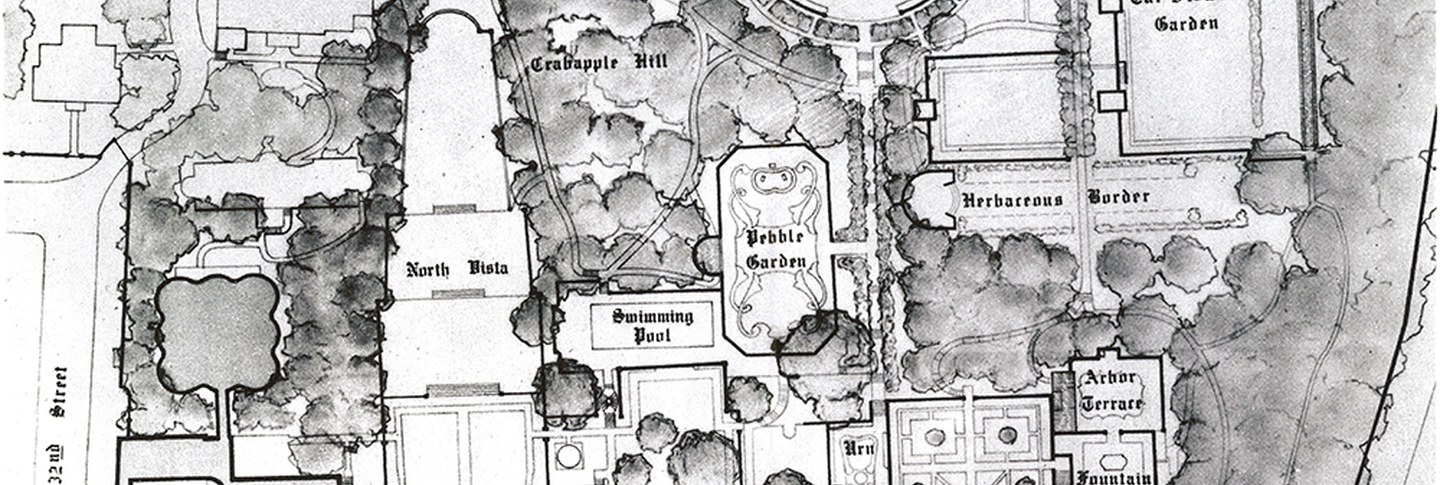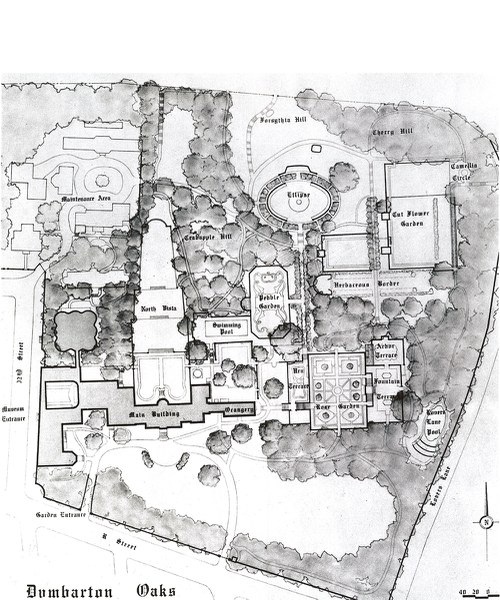The following is reproduced with permission from: Linda Lott, “The Arbor Terrace at Dumbarton Oaks: History and Design,” Garden History 31, no. 2 (2003): 209–17. Figures 4, 5, 6, 7, and 11 have been replaced, with the following credits: Figures 4, 6, and 11: Brett Davis, July 2016; Figure 5: Dumbarton Oaks Garden Archives, GD P-3-24A; Figure 7: Dumbarton Oaks Garden Archives, GD P-2-13B.
In her Plant Book, written for the future maintenance and preservation of the gardens at Dumbarton Oaks, Washington, DC, Beatrix Farrand (1872–1959) begins the description of ‘The Herb Garden and Wisteria Arbor’ (currently called the Arbor TerraceIn some of the early drawings, the Arbor Terrace is identified as the ‘E’ Terrace.) (Figure 1) by stating that:
This small terrace, with its elegant heartwood tidewater cypress arbor (which was replaced in 1955), has changed considerably in character. It was originally intended as an intimate garden, a ‘giardini segreti’ [sic],The term translates as a secret garden and generally refers to a small, strongly enclosed garden room in fifteenth-century Italian Renaissance gardens that grew out of the medieval tradition of the hortus conclusus. with emphasis on contrast between sunlight and shade, the sound of falling water, the scent of herbs, the movement of wind and birds.Diane Kostial McGuire (ed.), Beatrix Farrand’s Plant Book for Dumbarton Oaks (Washington, DC: Dumbarton Oaks Trustees for Harvard University, 1980), 71.
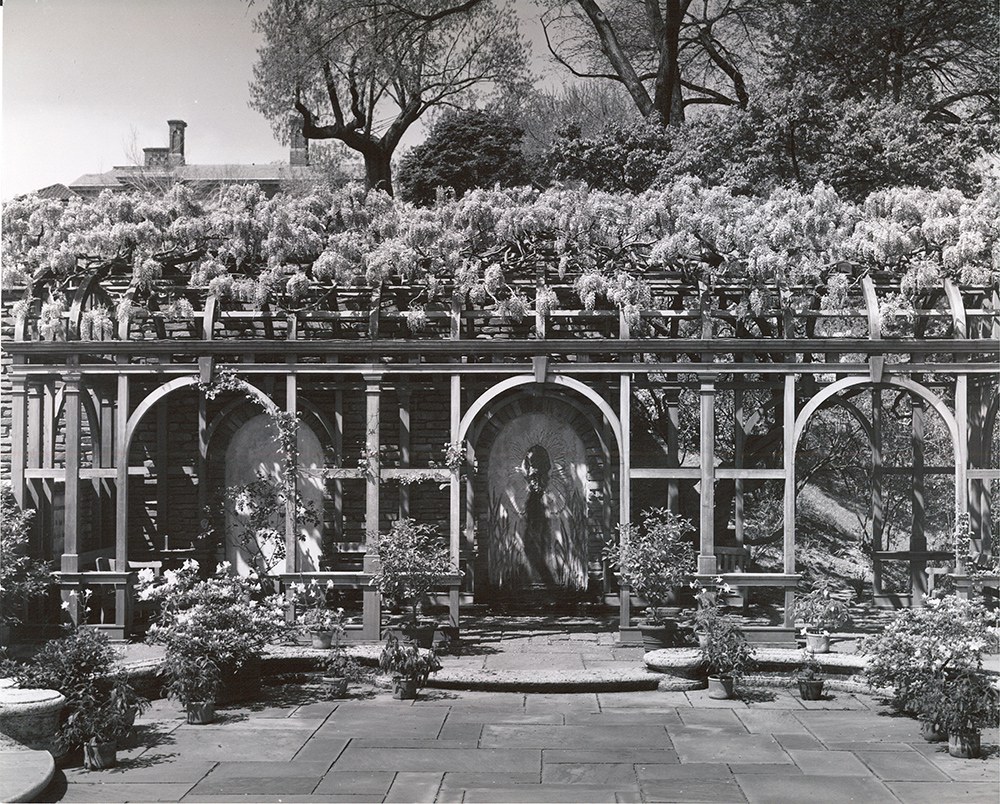
A discussion of the Arbor Terrace should logically begin with its most dominant feature; the Arbor (Figure 2). Farrand’s text provides an interesting overview (Figures 3–5):
It is not a display garden but, rather, one in which shaded seats can be occupied under the big Wisteria arbor, which was placed in this position in order to minimize the rather overwhelming height of the stone wall which was needed to retain the northeast corner of the Rose Garden. This arbor was modified from a design of Du Cerceau (from his drawing of the garden of the Chateau Montargis). It is planted almost entirely with Wisteria, mainly of the lavender variety but with some few plants of white. The Wisteria Arbor is designed so as to be seen from below, so that the hanging clutches of the flowers will make a fragrant and lovely roof to the arbor. In order to make the high wall less noticeable in its austerity, a wall fountain with an old, French, lead fountain head was designed; and a second niche, also ornamented with lead (which lead ornament needs revision), is placed to the south of the wall fountain, with a simple lead box under the arch in which a book or two might be left. This lead box had not proved practical, as the dampness in this position would ruin any book before many weeks.Ibid., 72. ‘Du Cerceau’ is Jacques Androuet Du Cerceau (c. 1515–85).
![Figure 3. Design for the arbour at the Château Montargis; from Jacques Androuet Du Cerceau, “Le premier [-second] volume des plus excellents Bastiments de France” (Paris, 1576–79).](https://www.doaks.org/newsletter/news-images/arbor3.jpg/@@images/6c46ce31-aa88-4476-971b-8f03f0dcb306.jpeg)
In July 1933, Caroline Phillips, a friend of Mildred B. Bliss, owner of Dumbarton Oaks, sent her a note thanking her for a visit to the garden and enclosing three quotations taken from Dante Alighieri’s Purgatorio (begun c. 1307). She wrote:
I have found three little extracts from Dante’s Earthly Paradise at the end of the Purgatorio, which I think fit into your garden. There might one day be a stone or block of wood to carry them on, if you want some words of the Divine Poet in your wood.The letter (dated 9 July 1933) is part of the Farrand-Bliss Correspondence at Dumbarton Oaks. The lines from the letter appear on pp. 2–3. Next to the canto selected is written: ‘For all of Dumbarton Oaks’.
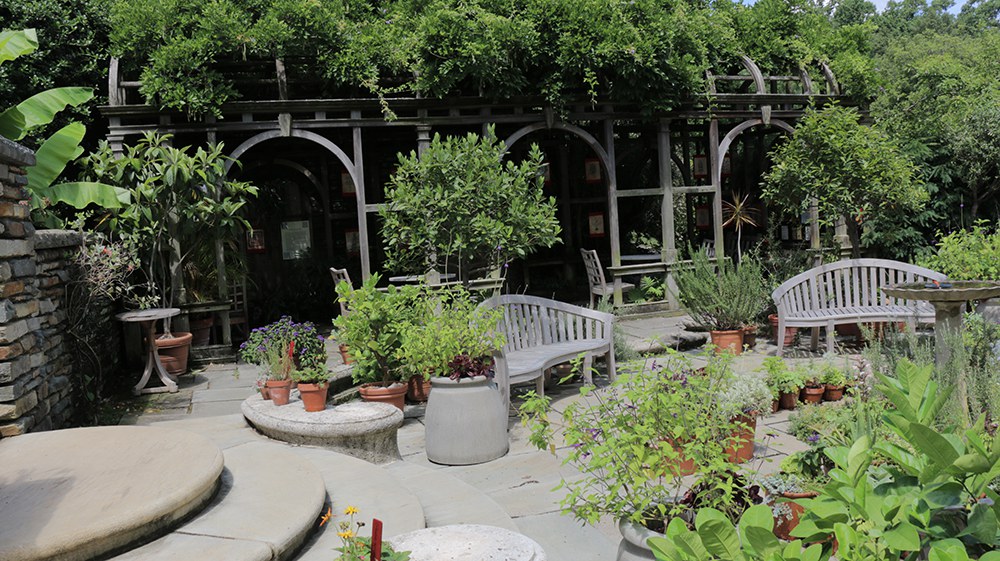

Bliss adopted only one of Phillips’ suggested quotations, lines 139–41 from Purgatorio, canto XXVIII: ‘Quelli chanticamente poetaro leta dell oro/ & suo stato felice forse in parnaso esto loco sognaro’, which was translated by Phillips as ‘Those who in olden times, sang of the Golden Age, and its happy state, perchance dreamed in Parnassus of this place’.The capitalization and spelling are as they appear in the quote on the Arbor Terrace. This phrase, along with the lead book box and lotus flowers, originally adorned the second niche of the Arbor Terrace, but the quotation has since been relocated to the low wall on the left inside the Arbor (Figure 6) and the other ornament removed, leaving a blank arch of masonry. Beneath the quotation appears the phrase ‘codice caetani’, indicating the edition from which it was taken, and the words ‘all amigo Gelasio’, an allusion to the Bliss’s friendship with Gelasio Caetani.
Caetani served as Italian Ambassador to the United States from 1920 to 1925 and owned Ninfa, in Lazio, among the loveliest gardens in Italy. Like his grandfather, Michelangelo Caetani, Gelasio was a Dante scholar, and, in 1930, he published a limited edition of three hundred copies of the Codex Caetani,The Dumbarton Oaks Library owns number 27. his family’s manuscript copy of the Divine Commedia.Don Gelasio Caetani (ed.), Comedia Dantis Aligherii Florentini (Sancasciano, Val de Pesa, 1930). The manuscript itself is written on parchment in a calligraphic hand of the late fourteenth or very early fifteenth century. Georgina Masson reported that Caetani transcribed for Bliss the quotation that so aptly described the beauties of his own garden at Ninfa and those of Dumbarton Oaks.Georgina Masson, Dumbarton Oaks: A Guide to the Gardens (Washington, DC: Trustees for Harvard University, 1968), 24. The appropriateness of the quotation is underscored when viewed in the context of the entire canto.
After passing through Hell, Dante had to climb the seven terraces of Mount Purgatory on his way to Heaven, the summit of the mountain, on which lay the Earthly Paradise or Garden of Eden. It is here where Dante, abandoned by Virgil, encountered Matilda,Robert M. Durling (ed.), The Divine Comedy of Dante Alighieri (Oxford: Oxford University Press, 2003), 484. Matilda can be seen to embody the innocent happiness of Eden: she is a sort of wood nymph or protective spirit of the place. For further information concerning the question of her identity, see A. Bartlett Giamatti, Earthly Paradise and the Renaissance Epic (Princeton: Princeton University Press, 1966), 107–8. who told him, ‘Here the root of Humanity is innocent: here is everlasting Spring, and every fruit: this is the nectar of which they all speak’.Dante, Purgatorio, canto XXVIII. Certainly, the Arbor Terrace, with its fountain, arbour, flowers and location, evokes the Earthly Paradise of which Matilda spoke. Just as Dante encountered a garden before his final ascent into Heaven, so a visitor to the Arbor Terrace discovers an Earthly Paradise.‘The Divine Comedy takes place in a structured, concentric universe through which Dante and his guides move so that he might learn the results of evil and the meaning of Divine Love. The setting of the poem is a constantly varying landscape, which changes with the state of the author’s soul and the condition of those whom he observes. In order to understand the joys of Paradise he must descend to the depths of Hell’; Margaretta J. Darnall and Mark S. Weil, ‘Il Sacro Bosco di Bomarzo. Its 16th-century literary and antiquarian context’, Journal of Garden History, IV (1984), 1–94 (p. 6). While Darnall and Weil are writing about Bomarzo, their text can also be applied to the Arbor Terrace.
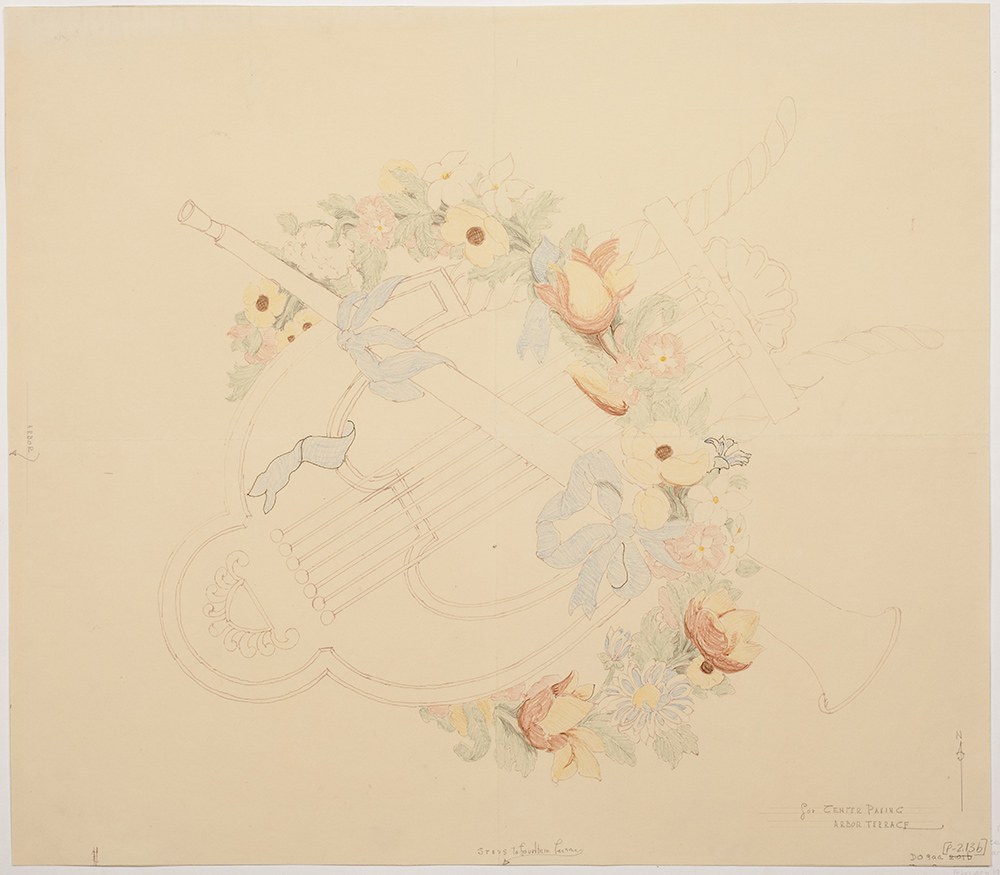
At this point, it is instructive to examine some of the drawings created for the Arbor Terrace from the mid-1930s. Possibly the theme of Mount Parnassus, mentioned in the quotation, was expanded upon and iconography representing Apollo was at one time to be subtly incorporated into the design scheme of the terrace. Mount Parnassus was sacred to both Apollo, god of archery, prophecy, music and healing, and to the Muses. One early drawing for the fountain depicts the head of a satyr and may have alluded to the story of Apollo and the satyr Marsyas, who challenged Apollo to a musical contest, lost and in defeat was flayed alive. Originally planned as a herb garden, the Arbor Terrace evolved into a pot garden and at present incorporates sweeping scrolls in the pavement design, but an early rendering shows the image of a flute lying diagonally over a lyre, partially framed with a spray of flowers (Figure 7). The iconography of both the flute and the lyre could refer to the fact that Apollo was the god of music, the flute also referring to his association with Marsyas. Furthermore, one of the designs for the Arbor Terrace has several wrought-iron gate finials with arrows incorporated into the design, possibly iconography associated with Apollo’s role as the god of archery. (The possibility also exists that the theme of Apollo might have been considered as a separate design scheme before the quotation from Dante had been selected. It may then have been decided to use personal rather than public language in the final design.)
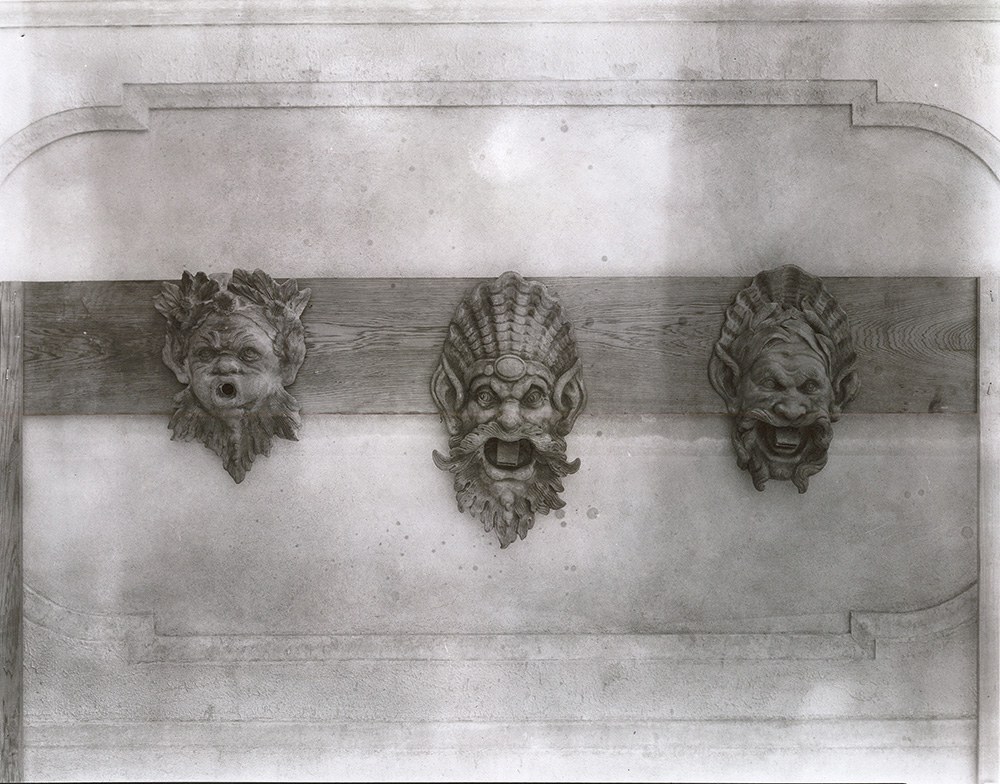
The fountain head selected for the final design of the Arbor Terrace has been identified, along with two others, as a river god (Figure 8).All three heads were purchased in May 1947 from Frances W. Huard (antiquarian), Versailles, France; Dumbarton Oaks House Collection Files. Barbara Israel, however, provides a different theory supporting the identification of the head as a river god:
Although the mask does not strictly conform to traditional images of Poseidon, or Neptune, the cattails, which are echoed at the base of the wall fountain, suggest rivers and wetlands, which fell within the sea god’s kingdom. The rays of sunlight, however, may allude to Apollo, the Greek god of music, song, and light, indicating instead a modern representation of that mythological deity.Barbara Israel, Antique Garden Ornament: Two Centuries of American Taste (New York: Harry N. Abrams, 1999), 130.
The current fountain, occupying the wall of the right arch, went through a number of revisions before the final design was selected: the head of a mythological god, perhaps a river god or Apollo, surrounded by sheaves of wheat, an element from the Bliss family coat of arms (Figure 9).Sheaves of wheat are also to be found on numerous gates at Dumbarton Oaks: in the design of the Pebble Garden and in the bench in the Rose Garden. While the lotus flowers placed either side of the book box have no connection with Apollo, their selection for the arch on the Arbor Terrace might be a reference to mythology and the story of Odysseus in the country of the lotus-eaters.In Homer’s Odyssey, Odysseus and his crew encountered the country of the lotus-eaters while journeying home to Ithaca. Odysseus sent three men to find out who inhabited the island. They were entertained by the Lotus-eaters, were given some of the food of the lotus plant and, as a result, lost all desire to return home. The dream-like state induced by the lotus plant may have provided the inspiration to use lotus flowers in the arch and might refer to the phrase in Dante’s quotation on the Golden Age: ‘perchance dreamed in Parnassus of this place’.
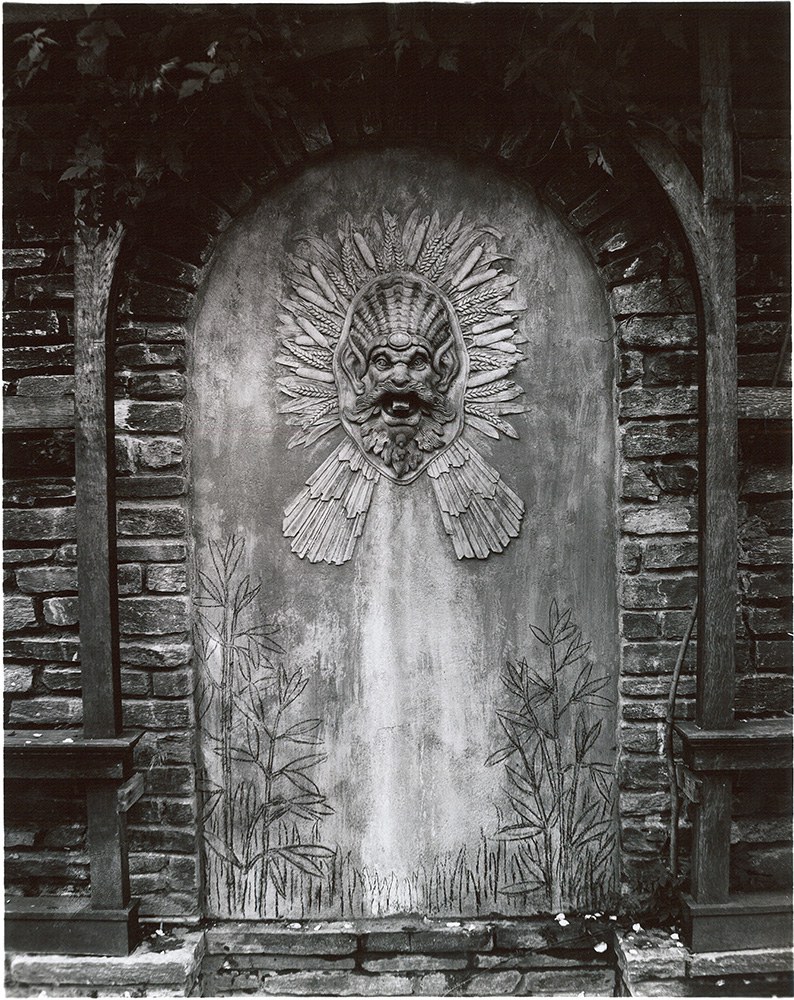
Could these drawings and ornaments have been part of a conscious programme for the design of the Arbor Terrace, employing subtle references to Apollo and to mythological elements in the Odyssey? While there is no documentation to support this hypothesis and no references made to Apollo in the correspondence between Farrand and Bliss, the allusions evoked by the images mentioned are difficult to ignore. The only other mythological references currently found in the gardens appear in the Star Garden and the mosaics in the Swimming Pool Loggia, which depict the story of Diana and Actaeon.A watercolour by Allyn Cox (1896–1982) of Diana and Acteon has written in pencil in the lower right-hand corner: ‘first sketch for a loggia decoration, Allyn Cox, 1927’.
As Farrand indicated in her Plant Book, the original design for the Arbor Terrace grew out of an Italian garden tradition, the giardini segreti. While it is not possible to discuss the tradition of Italian gardening and Humanism within the scope of this note, it is instructive to look briefly at one text that was widely read in the fourteenth and fifteenth centuries. Pietro de’ Crescenzi’s thirteenth-century Latin treatise on agriculture, Liber ruralium commodorum,De’ Crescenzi drew on the writings of ancient Romans such as Cato, Columella, Varro and Palladius, as well as on his own experience as a country landowner. His work began its wide circulation in manuscript form in 1305, and was one of the earliest printed books in Europe: in Latin in 1471, in Italian in 1478, in French in 1486 and German in 1493. described the construction and design of gardens from the 1300s to the Renaissance. Book VIII, Chapter 3, focuses on pleasure gardens and is divided into three classes: those of poor men, those of modest means, and those of wealthy nobles and kings. The following passage has particular relevance to the design of the Arbor Terrace:
Each of these [gardens] should be adorned with sweet-scented flowers, arbours of clipped trees, grassy lawns, and if possible, a sparkling fountain to lend joy and brightness to the scene. A pergola of vines will afford shade in the noonday heats, but in small gardens it is well to plant no trees on the lawn, and to leave the grass exposed to the pure airs and sunshine.Quotation in Julia Cartwright, Italian Gardens of the Renaissance and Other Studies (New York: Charles Scribner’s Sons, 1914), 2–3. The translations are also given by Robert G. Calkin, ‘Pietro de’ Crescenzi and the medieval garden’, in Elisabeth B. MacDougall (ed.), Medieval Gardens (Washington, DC: Dumbarton Oaks Colloquium on the History of Landscape Architecture, 1983), 155–73; and Frank Crisp, Medieval Gardens: ‘flowery medes’ and Other Arrangements of Herbs, Flowers, and Shrubs Grown in the Middle Ages, with Some Account of Tudor, Elizabethan, and Stuart Gardens (London: John Lane, 1924), 15–19.
While the text itself might not have been a direct influence, it can be seen that elements listed in de’ Crescenzi’s text, and depicted in a later variant edition at Dumbarton Oaks (Figure 10)Pietro de’ Crescenzi, II libro della agricultura(Venice: Matteo Capasca di Codeca, 1495).
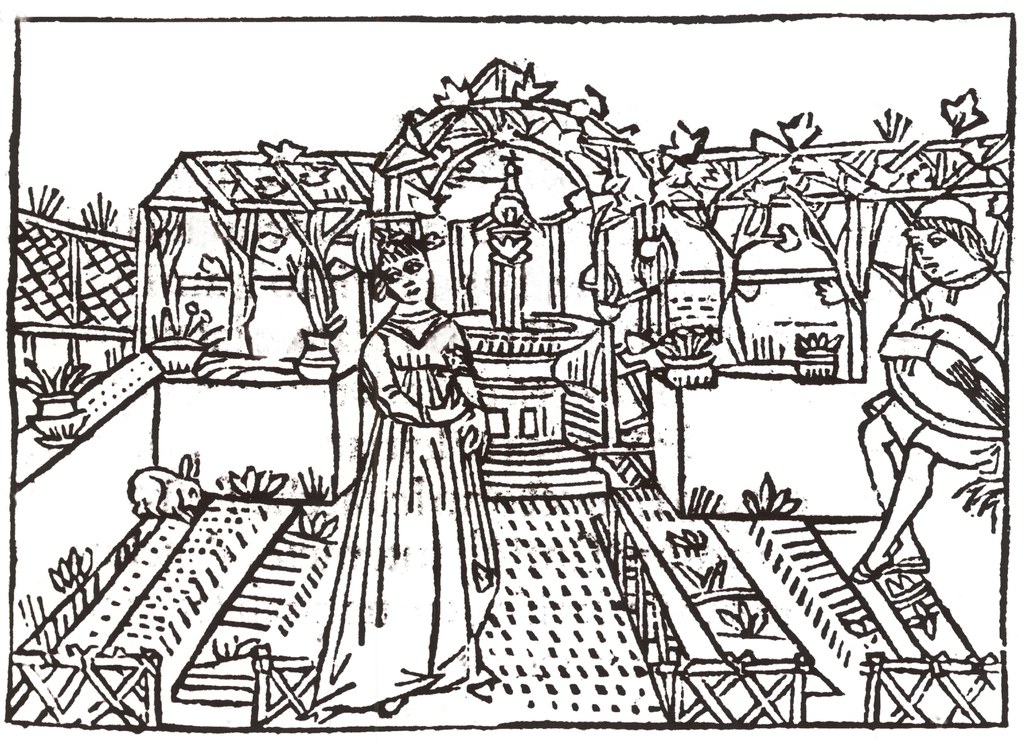
In the preamble to Bliss’s will, a passage again echoes the Humanist theme found in Farrand’s Plant Book:
Those responsible for scholarship at Dumbarton Oaks should remember that gardens have their place in the Humanist order of life; and that trees are noble elements to be protected by successive generations and are not to be neglected or lightly destroyed . . . the serenity of open spaces and ancient trees . . . are as integral a part of Humanism at Dumbarton Oaks as are the Library and the Collections.Preamble to the will of Mildred B. Bliss, 31 August 1966.
The sentiment also appears, in modified form, on the plaque that flanks the right-hand side of the Museum entrance on 32nd Street, which also functions as a portion of the outside wall of the Rare Book Room of the Garden Library (designed and constructed to house Bliss’s collection of rare materials). At the top of the plaque is the phrase Quiescit Anima Libris (The spirit finds rest in books). This phrase is taken from the inlaid inscription on the sixteenth-century Italian bookcase cabinet in the Music Room and also recalls the lead book box originally housed in the Arbor Terrace. It is possible to View these as unifying, integral elements at Dumbarton Oaks, connected in part by their form and function, but also united by Humanist ideals. The concept of unity can be taken a step further with other design elements, such as the oak leaves and acorns on the wrought-iron railings in the main portion of the house (Figure 11) that help to bring nature indoors.
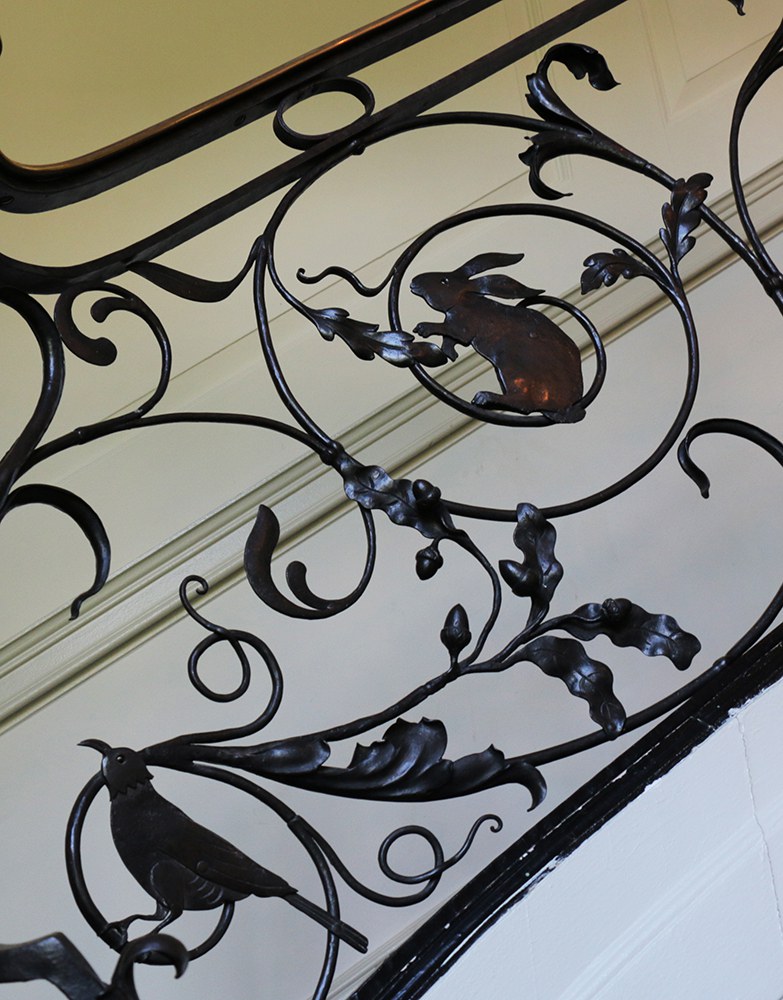
The current design of the Arbor Terrace is a distant echo of its former past as the terrace and its arbour wall have suffered over time, principally because of its location. As Farrand stated, it functions as a retaining wall for the Rose Garden, and in the past, the task of watering so many bushes was accomplished by flooding the entire Rose Garden. Over time, the flow of water and chemicals through the weep holes have clogged them and created an inhospitable environment for both the masonry and the original lead ornaments, causing them to deteriorate.In conversations the author has had with Gail Griffin, Superintendent of Gardens and Grounds at Dumbarton Oaks, the problems of conservation and preservation that exist on the Arbor Terrace have been discussed. The lead book box, as Farrand had predicted, was not practical for the setting and was eventually removed from the wall, along with the lotus flowers. There are several letters from Ruth Havey (1899–1980), an employee at Farrand’s office from the summer and fall of 1949, that included information about renovation work on the Arbor Terrace. Another note from Havey dated 1954 stated: ‘handle of lead cabinet is missing. Replace or cover the hole with a small plaque of lead’. Havey’s sketches presented alternative solutions to the problem of the walls, described in her text as ‘Sketch—two panels in arbour wall without lead lotus and bulrushes—leave waves’. None of Havey’s suggestions for the arches has ever been implemented. The paradigm for the garden that Mildred B. Bliss, Beatrix Farrand and Ruth Havey envisioned might exist in the early drawings and correspondence. The gardens as a whole, as well as individual areas, warrant closer study and examination.
